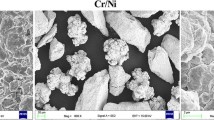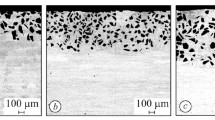Abstract
Using a high-power CO2 laser, aluminum-surface alloying was carried out on a nickel-base superalloy (Nimonic 80A) with the aim of improving its oxidation resistance. After the treatment, scanning-electron microscopy (SEM) studies show the alloy area to have a two-phase structure of Ni solid solution and Ni3Al intermetallic. These layers were subsequently subjected to a laser-remelting treatment with different beam-scanning speeds in order to homogenize their structure. Metallographic studies indicate the formation of a single dendritic phase rather than the two-phase structure present in the unmelted alloyed tracks and a decrease in the aluminum content throughout the laser track. To establish their oxidation behavior at high temperatures, the alloyed layers and remelted alloyed layers were oxidized at 1273 K for varying times, between 24 and 300 hr, comparing their behavior with that of untreated specimens. The results indicate the formation of a protective alumina layer on the alloyed specimens. The oxidation behavior differs, depending on the scanning rate (of the laser beam over the specimen surface) during remelting. Oxidation of the remelted specimens at the maximum rates studied (500 mm/min) leads to the formation of protective oxides on the superalloy. However, when remelting takes place at lower rates (100 and 300 mm/min), the amount of aluminum present is insufficient to develop a continuous protective-oxide layer.
Similar content being viewed by others
REFERENCES
C. T. Sims, W. S. Stollof, and W. C. Hagel (eds.), Superalloys II (Wiley, New York, 1987).
J. L. Gonzalez Carrasco, P. Adeva, and M. Aballe, Oxid. Met. 33, 1 (1990).
H. L. Du, P. K. Datta, J. S. Burnell Gray, A. S. James, and A. Matthews, Surf. Coat. Technol. 81, 151 (1996).
M. Misbahul Amin, Thin Solid Films 299, 1 (1997).
Y. C. Pan, T. H. Chuang, and Y. D. Yao, J. Mater. Sci. 26, 6097 (1991).
J. H. Abboud, D. R. F. West, and R. D. Rawlings, Mater. Sci. Technol. 10, 848 (1994).
S. Zhu, F. Wang, H. Lou, and W. Wu, Surf. Coat. Technol. 71, 9 (1995).
U. Brill, Wekst. Korros. 411, 682 (1990).
J. de Damborenea, V. López, and A. J. Vázquez, Surf. Coat. Technol. 70, 107 (1994).
A. Gutierrez and J. de Damborenea, Appl. Phys. A 63, 461 (1996).
J. J. de Damborenea and A. J. Vázquez, J. Mater. Sci. 27, 1271 (1992).
S. M. Merchant and M. R. Notis, Mater. Sci. Eng. 66, 47 (1984).
Author information
Authors and Affiliations
Rights and permissions
About this article
Cite this article
Rodriguez, G., García, I. & Damborenea, J. Effects of Laser Surface Modification of Nimonic with Aluminum on Oxidation Behavior. Oxidation of Metals 58, 235–248 (2002). https://doi.org/10.1023/A:1016028911317
Issue Date:
DOI: https://doi.org/10.1023/A:1016028911317




